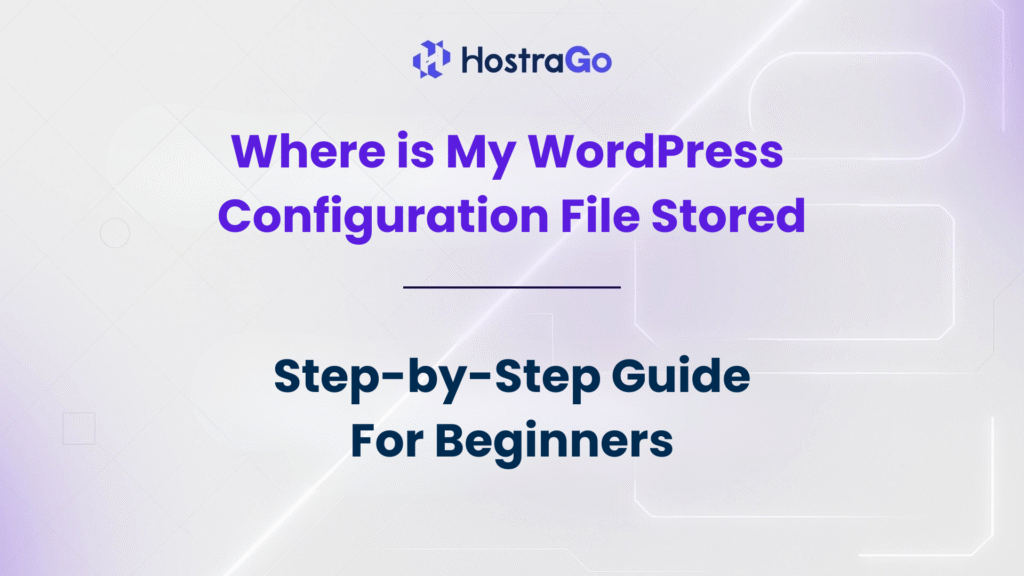If you are managing a WordPress website, you might have come across the term WordPress configuration file many times. This important file, known as wp-config.php, is the backbone of your site’s functionality. Without it, WordPress wouldn’t know how to connect to your database, store your settings, or run properly. Many beginners often ask, “Where is my WordPress configuration file stored?”—and the answer is crucial for anyone who wants full control over their WordPress site.
The WordPress configuration file holds sensitive details like database credentials, security keys, and configuration settings. If you are planning to make changes such as moving your website, updating database details, or enhancing site security, you’ll need to locate and sometimes edit this file carefully. In this article, we’ll guide you step by step on where to find the WordPress configuration file, what it contains, and best practices to edit it safely.
What is the WordPress Configuration File (wp-config.php)?
The wp-config.php file is the main configuration file in WordPress. It is automatically created when you install WordPress, and it stores the most critical information that allows WordPress to work seamlessly with your web hosting environment.
Here’s what it usually contains:
- Database name, username, password, and host details.
- Authentication unique keys and salts for improved security.
- WordPress debugging mode settings.
- File and memory limits.
- Table prefix details for your WordPress database.
Without this file, WordPress cannot communicate with your database, making it one of the most essential files on your server.
Where is the WordPress Configuration File Stored?
By default, the WordPress configuration file (wp-config.php) is stored in the root directory of your WordPress installation. This is the same folder where you’ll also find other important files such as wp-content, wp-admin, and wp-includes.
If you are accessing your hosting account via cPanel File Manager or FTP client (like FileZilla), simply open the folder where your WordPress files are located. For most websites, this is usually:
/public_html/(if WordPress is installed on your main domain)/public_html/yourdomain/(if WordPress is installed in a subfolder)/subdomain/folder (if WordPress is installed on a subdomain)
Can the wp-config.php File Be Moved?
Yes, you can move the WordPress configuration file one level above the root directory for added security. This prevents hackers from easily accessing it in case of vulnerabilities.
For example:
- Default path:
/public_html/wp-config.php - Moved path:
/home/username/wp-config.php
WordPress is smart enough to detect this change automatically. However, before attempting this, always make a full backup of your website files and database.
How to Edit the WordPress Configuration File Safely
Sometimes, you may need to edit your wp-config.php file—for instance, to enable debugging, increase memory limits, or change database settings. Here are the safe ways to do it:
- Backup First: Always take a backup of your site using tools like UpdraftPlus or your hosting backup option.
- Access via File Manager: Log in to your Hostrago cPanel (if available) and open the File Manager.
- Use FTP: Connect with an FTP client and navigate to your WordPress root directory.
- Open with a Code Editor: Use a plain text editor (like Notepad++ or VS Code) instead of Word or Google Docs.
- Save & Re-upload: After editing, save changes and re-upload the file carefully.
Why is wp-config.php Important for WordPress Security?
The WordPress configuration file stores highly sensitive information like database login details and authentication keys. If compromised, hackers could gain full control of your site. That’s why security best practices include:
- Moving the file above the root directory.
- Setting correct file permissions (typically
400or440). - Disabling file editing from the WordPress admin dashboard.
- Regularly updating your database password and keys.
Final Thoughts
To sum it up, the WordPress configuration file (wp-config.php) is stored in the root directory of your WordPress installation. It’s a powerful file that determines how your WordPress site communicates with its database and how securely it operates.
Whether you’re editing, moving, or simply locating this file, always proceed with caution and ensure you have backups in place. At Hostrago, we provide WordPress hosting solutions that make file management simple, secure, and beginner-friendly.
By understanding the location and importance of the WordPress configuration file, you’ll gain more control over your website and improve both its performance and security.


